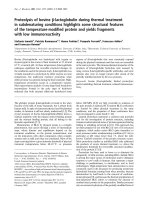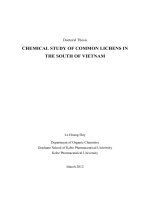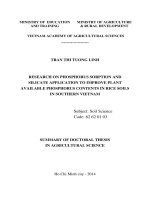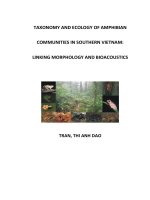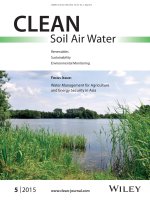Some circulation features during South-West monsoon in southern Vietnam''s waters
Bạn đang xem bản rút gọn của tài liệu. Xem và tải ngay bản đầy đủ của tài liệu tại đây (2.8 MB, 8 trang )
Journal of Marine Science and Technology; Vol. 17, No. 3; 2017: 263-270
DOI: 10.15625/1859-3097/17/3/10828
/>
SOME CIRCULATION FEATURES DURING SOUTH-WEST
MONSOON IN SOUTHERN VIETNAM’S WATERS
Le Dinh Mau*, Nguyen Chi Cong, Nguyen Van Tuan
*
Institute of Oceanography, VAST
E-mail:
Received: 10-8-2016
ABSTRACT: This paper presents some circulation features during South-West (SW) monsoon
in Southern Vietnam’s waters. The data were collected from different projects which were carried
out by the Institute of Oceanography in recent years. Study results show that during SW monsoon
the current mostly flows from the south to the north by wind action, and it is the period of high
Mekong river discharge. These conditions are the main causes of Mekong river water spreading to
the Central Vietnam upwelling area. Measured data during August and September 2009 indicate
that Mekong River water spreads up to about 80 km to 100 km offshore, inclining in the northern
part of Mekong river mouth region towards the upwelling area. The extent of river water spreading
is directly proportional to the Mekong river discharge and SW monsoon intensity. This phenomenon
is significant feature for assessment of the ecological-environmental effects on the upwelling area.
Keywords: Current, Mekong river, upwelling, ecological-environmental, monsoon.
INTRODUCTION
Circulation pattern in Southern Vietnam’s
waters is driven mostly by the East Asian
monsoon, tidal regime and extreme events such
as typhoon, coastal flood,... The main
oceanographic features are the “westward
intensification effect” during North-East (NE)
monsoon, and upwelling phenomenon during
SW monsoon, the dispersion of Mekong river
waters to the Eastern Vietnam Sea. These
oceanographic processes
have effected
ecosystem and marine biological resources in
the studied area. The circulation system in the
Eastern Vietnam Sea has been studied by
several researchers; especially, Shaw and Chao
(1994) [1] used 3D circulation model to study
the surface circulation, Pohlmann (1987) [2]
developed a 3D circulation model. Dinh Van
Uu (2011) [3] has developed a forecasting
model system on hydrodynamic processes.
Herein, the features of strong cold current
system flowing from the north to south the
during NE
monsoon
and upwelling
phenomenon during SW monsoon in studied
area were presented. In South Vietnam waters
the remarkable study conducted by Hein et al.,
(2013) [4] focused on the feature of interannual variability of upwelling off the Southern
Vietnam’s coast and its relation to nutrient
dynamics, that by Hein et al., (2013) [5]
focused on the sediment dynamics in the region
of Mekong river water influence. The main
meteo-hydrological features were studied by Le
Dinh Mau et al., (2011) [6]. However, most of
above study results were based on numerical
model whereas this study result is mainly based
on observation data which were carried out by
the Institute of Oceanography (IO) in recent
years under the international cooperation
project between Vietnam and Germany (20032009). The content of this paper focuses on the
263
Le Dinh Mau, Nguyen Chi Cong,…
feature of circulation pattern and spreading of
Mekong river waters to the upwelling region in
Southern Vietnam’s waters with the studied
area covering the waters from Khanh Hoa to Ca
Mau including Phu Quy and Con Dao islands.
Location and feature of studied area are shown
in fig. 1.
1/50,000 published in 2004 by Vietnamese
Navy [6]. Hydrodynamic data were collected
from five cruises for low (4/2007, 4/2010) and
high (8/2009, 9/2008, 9/2009) Mekong river
discharges. Field investigated stations are
shown in fig. 2a, 2b, 2c, 2d.
0
11
Phanthiet
Tp.HCM
Vungtau
Phuquy Island
Tiengiang
20
21122232425
10
Bentre
0
2
Travinh
Soctrang
Baclieu
9
18
17
16
3
4
5
6
78
9
19
10
15
14
13
12
11
0
0
Condao Island
: depth contours (m)
: measured stations
8
: continuous stations
0
0
105.5
106
0
107
0
108
0
0
109
Fig. 2a. Measured stations of cruise 4/2007
106.0
11.0
106.5
107.0
107.5
108.0
11.0
Phanthiet
Fig. 1. Bathymetry of the Eastern Vietnam Sea
and location of the studied area
Tp.HCM
10.5
10.5
Vungtau
37
2
1
3
MATERIAL AND METHOD
The main data of this paper were based on
recent study results from different projects
which were carried out by the Institute of
Oceanography, especially “Study on the
upwelling phenomenon and related processes”
(Vietnamese - German Joint Project: 20032006), “Study on the interaction between
Mekong river waters and upwelling region”
(Vietnamese - German Joint Project: 20072010) and some related projects. Herein, wind
data were collected from Phu Quy station
(1987-2007), Mekong river discharge data were
collected from Can Tho and My Thuan stations
(1997-2007), hourly water level data were
collected from Vung Tau station (1987-2006),
bottom topography in the studied area was
taken from hydrographic map with scale of
264
36
5
Bentre
10.0
13 11
12
15
635
7
34
9
10
8
10.0
33
32b
32
16
17b
17
31
Travinh
30
9.5
23
Soctrang
18
29
19
25
24
22
27
21
20
: depth contours (m)
: measured stations
(floating)
: measured stations
(anchorage)
: continuous stations
AS1
26
9.0
106.0
9.5
0
28
106.5
107.0
107.5
0
9.0
0
108.0
Fig. 2b. Measured stations of cruise 9/2008
The measurement instruments used are Seabird equipment for water temperature and
salinity, Alex-compact equipment for current
parameters. Continued stations (LT) for 25
hours were carried out at Cung Hau - Co Chien
mouth area and at Vung Tau transect. The
remaining stations were measured by mooring
Some circulation features during south-west…
ship. Circulation system in upwelling area were
computed by HAMSOM model (HAMburg
Shelf Ocean Model) which was developed by
Hamburg
University
( />OM) [4]. The reference to estimate the
influence of fresh water on the sea was based
on the NAGA Expedition Report “The physical
oceanography of the Gulf of Thailand” by
Robinson in 1974 [7].
Phanthiet
: depth contour (m)
Tp. HCM
10.5
: continuous measured
stations
0
50 Km
Tie n
Ha
Scale: 1/200 000
Riv e
r
So
aø i
Tiengiang ra p M
Vungtau
ou
uR
1
2(I)
3
th
Dai Mouth
ive
r
Bentre
10
Phuquy Island
: measured stations
4
Hamluong Mouth
5
6
Cunghau Mouth
7 (II)
8
Dinhan Mouth
9
13
10
Travinh
Soctrang
9.5
Southern part (Vung Tau - Ca Mau) with
main feature being the coastline is also lying in
NE-SW direction. The coast can be divided
into several parts by different estuaries. The
shelf is relatively less sloping compared with
that of the northern part, with the depth contour
of 30 m lying at distance of ≈ 100 km offshore.
Suspended matter concentration from the
Mekong river is relatively high.
Meteo-hydrological conditions
11
14
12
Baclieu
directions (NE and SW monsoons). The coast
can again be divided into several sections by
headlands which form bay with the mouth in
SE direction. The shelf has a relative slope with
the depth contour of 200 m lying at distance of
about 100 km offshore. Almost all the rivers
are short, suspended matter concentrations are
relatively low.
15
Distribution feature of SW monsoon wind
in the studied area is shown in fig. 3.
16
9
17
Camau
18
Condao Island
8.5
105
105.5
106
106.5
107
107.5
108
HOA GIOÙ
Station: Phu Quy Is.
Trạm: Phú Quý
Data: 1987-2007
Thời gian: Tháng 7 (1987-2007)
Time: July
Fig. 2c. Measured stations of cruises 9/2009
and 4/2010
5.6
2604
Thang tỉ lệ
Occurrent Frequency Scale Bar
0%
5%
10 %
0.3
1.6
3.4
15 %
5.5
20 %
8.0
25 %
10.8
30 %
13.9
m/s
Fig. 3. Wind rose diagram at Phu Quy station
in July (1987-2007)
Fig. 2d. Measured stations of cruise 8/2009
STUDY RESULTS
Features of natural conditions
Southern Vietnam’s Coast
along
Geo-morphological features
The northern coast of studied area (Nha
Trang to Vung Tau) is lying in NE-SW
direction, it means the coastline direction is
parallel with two main monsoonal wind
The data in fig. 3 show the distribution of
wind velocity and direction at Phu Quy station
(offshore region of studied area) which indicate
that during SW monsoon the wind direction is
in the sector from SW to W.
Typhoons in the studied coast mostly occur
from October to December, especially in
November. The coast from Binh Thuan to Ca
Mau is less affected by typhoons. The
occurrence of typhoons is delayed from the
265
Le Dinh Mau, Nguyen Chi Cong,…
northern part (November) to southern part
(December) of the studied area.
The tidal regime along the studied coast is
from irregular diurnal tide in the northern part
to irregular semi-diurnal tide in the southern
part. Mean high tide amplitude is
approximately 1 m along northern coast (Nha
Trang - Vung Tau), and about 2 m along
southern coast (Vung Tau - Ca Mau).
Mekong river discharge
Mekong river in Vietnam is divided into
two main branches that are Hau and Tien
rivers. River discharge data (from 1998 to
2007) at two branches were collected (My
Thuan station on Tien river; Can Tho station on
Hau river). Analysis results show that the
variations of monthly river discharge at two
stations are similar to the maximum value in
September and the minimum value in March
and April (fig 4a, 4b). In the flood season (July
- December) the discharge ranges from
4,000 m3/s to 15,800 m3/s, in the dry season
(January - June) the discharge value is less than
4,000 m3/s for each station. The minimum
value of discharge was 760 m3/s in April 2004
at Can Tho station and 800 m3/s in March 2005
at My Thuan station.
Fig. 4a. Variation of monthly river discharge at My Thuan station from 2001 to 2007
(Vertical axis: River discharge(m3/s); Horizontal axis: Months)
Fig. 4b. Variation of monthly river discharge at Can Tho station from 1999 to 2007
(Vertical axis: River discharge; Horizontal axis: Months)
Circulation
features
and
upwelling
phenomenon in Southern Vietnam’s waters
Upwelling phenomenon
266
Using HAMSOM model [4] to simulate the
circulation in order to analyze the upwelling
processes in the studied area, the modeled
results are illustrated in fig. 5a. The study
Some circulation features during south-west…
results show that during SW monsoon the
northern part of studied area (from Nha Trang
to Vung Tau) is in upwelling region with the
(a) Winter season
center being Ninh Thuan’s waters. This result
is according to satellite data (fig. 5b).
(b) Summer season
Fig. 5a. Computed vertical velocity during NE and SW monsoons
(Blue color indicates upwelling; Red color indicates down welling)
Fig. 5b. Satellite image showing the upwelling phenomenon in South Vietnam waters [8]
267
Le Dinh Mau, Nguyen Chi Cong,…
Circulation features in Southern Vietnam’s
waters
the current pattern for SW monsoon period
(fig. 6). It indicates that during SW monsoon
the current flows from the south to the north.
That means the Mekong river waters can spread
to upwelling area.
Base on measured data from different
projects carried out in the recent years, we have
105
12
106
107
108
109
110
105
12 12
Phan Rang
50 cm/s
11
Thph. HỒ CHÍ MINH
Phan Thiết
106
107
108
109
110
12
Phan Rang
50 cm/s
11 11
Thph. HỒ CHÍ MINH
Vũng Tàu
Phan Thiết
11
Vũng Tàu
Cần Thơ
Cần Thơ
10
9
10 10
10
9
9
o
9
o
N
N
8
105 oE
106
107
108
109
8
110
8
105 oE
106
107
106
107
108
June
105
12
106
107
8
110
July
108
109
110
105
12 12
108
Phan Rang
109
110
12
Phan Rang
50 cm/s
50 cm/s
11
Thph. HỒ CHÍ MINH
Phan Thiết
11 11
Thph. HỒ CHÍ MINH
Vũng Tàu
Phan Thiết
11
Vũng Tàu
Cần Thơ
Cần Thơ
10
9
10 10
10
9
9
o
9
o
N
8
105 oE
109
N
106
107
108
109
8
110
August
8
105 oE
106
107
108
109
8
110
September
Fig. 6. Surface current pattern in SW monsoon
Spreading of Mekong river waters
Mekong river mouth and upwelling areas
are the most important regions for economic
development and environmental protection of
Vietnam. This section presents the dispersion
of Mekong river waters to the Eastern Vietnam
Sea, especially to the upwelling area. Study
results show that during SW monsoon season
and high river discharge, the waters from
Mekong river mouth region spread into the
268
upwelling area. In September 2009, the
Mekong river waters with S ≤ 32 psu spread
up to 80 - 100 km offshore with the thickness
of about 15 m (fig. 7a) and spread northwards
to La Gi region (fig. 7b) with the thickness of
about 10 m. During August 2009 an intrusion
of Mekong river waters was observed on the
Vung Tau transect with the thickness from the
surface to the bottom (fig. 7c). Data from
satellite images (fig. 7d) agreed with measured
ones.
Some circulation features during south-west…
0
Comments:
The features of upwelling and Mekong
river water spreading into the Eastern Vietnam
Sea depend on the conditions of the western
boundary current in the Eastern Vietnam Sea
and on the Mekong river discharge.
-5
-10
-15
-20
0
50 Km
10.5
So ân
14
-10
Vịng Tµu
g Tie
So
âng
H
àn
Tiền Giang
Trà Vinh
Sóc Traêng
9.5
16
-8
18
-6
20
-4
22
-2
0
2
4
6
8
10
12
Fig. 7b. Distribution of salinity (psu) at
anchored station (Vung Tau transect)
during 14 h/19/8 - 12 h/20/8/2009 (Horizontal
axis: times-h; vertical axis: water depth-m)
Beỏn Tre
aọu
Kiên Giang
10
Baứ Rũa-Vuừng Tau
Tp. HCM
W
Baùc Lieõu
E
0
Tr.1
9
Depth (m)
-10
Cà Mau
Coõn Ñaûo
Tr.2
-20
Tr.3
8.5
105
105.5
106
106.5
107
107.5
108
Fig. 7a. Distribution of the thickness (m) of
Mekong river waters in September 2009
(S ≤ 32 psu)
Tr.4
-30
Tr.5
Tr.6
m
107.0
107.2
107.4
Tr.7
107.6
Tr.8
Tr.9
o
107.8 N
Tr.10
Fig. 7c. Distribution of salinity (psu) along the
transect Dai Mouth - La Gi (8/2009)
Fig. 7d. SPM concentration on 24/9/2009 (MODIS Image)
During the SW monsoon and high river
discharge, Mekong river waters spread up to
about 80 km to 100 km offshore, inclining to the
northern part of the studied area towards the
transect between Ke Ga headland and Phu Quy
island. The extent of Mekong river waters with
characteristics of S ≤ 32 psu in case of high river
discharge and prevailing SW monsoonal wind
can reach Phan Thiet and enter the Con Dao and
Phu Quy island regions. The transect Phan Thiet
269
Le Dinh Mau, Nguyen Chi Cong,…
- Phu Quy marks the front of two water masses
(upwelling and Mekong river waters) (fig.7d). In
case of highest Mekong river discharge
(10/2005), the river waters can reach as far as
200 km offshore. The thickness of Mekong river
waters (S ≤ 32 psu) at the transect Long Hai (off
Vung Tau) is about 10 m.
2.
CONCLUSIONS
The main hydrodynamic processes in
Southern Vietnam’s waters are driven by the
monsoonal wind regime. Remarkable features
are the region of strongest upwelling occurring
in Ninh Thuan - Binh Thuan waters during the
SW monsoon.
3.
Measured data during August and
September 2009 indicate that Mekong river
waters (S ≤ 32 psu) spread up to about 80 km to
100 km offshore, inclining to the northern part
towards the transect between Ke Ga headland
and Phu Quy island (upwelling area).
4.
The extent of river water spreading is
directly proportional to the Mekong river
discharge and SW monsoon intensity.
Spreading of Mekong river waters to the
upwelling area is significant data for
assessment of the ecological-environmental
effects on the upwelling area.
5.
Acknowledgements: The authors gratefully
acknowledge all colleagues in the Institute of
Oceanography for their kind help and
encouragement throughout the preparation of
this paper.
6.
7.
REFERENCES
1. Shaw, P. T., and Chao, S. Y., 1994. Surface
270
8.
circulation in the south China Sea (Eastern
Vietnam Sea). Deep Sea Research Part I:
Oceanographic Research Papers, 41(1112), 1663-1683.
Pohlmann, T. (1987). A three dimensional
circulation model of the South China Sea
(Eastern
Vietnam
Sea). Elsevier
oceanography series, 45, 245-268.
Dinh Van Uu, 2011. Easttern Vietnam Sea
modeling system for marine environmental
prediction and monitoring. Proceedings of
the 5th National Conference on Marine
Science and Technology, Hanoi, Oct. 2011,
Vol. 2: Marine Hydrometeorology and
Dynamics, pp. 43-49.
Hein, H., Hein, B., Pohlmann, T., and
Long, B. H., 2013. Inter-annual variability
of upwelling off the South-Vietnamese
coast and its relation to nutrient
dynamics. Global
and
planetary
change, 110, 170-182.
Hein, H., Hein, B., and Pohlmann, T., 2013.
Recent sediment dynamics in the region of
Mekong water influence. Global and
Planetary Change, 110, 183-194.
Le Dinh Mau, Pham Sy Hoan, Vu Tuan
Anh, Nguyen Chi Cong, Nguyen Ba Xuan,
2011.
Some
meteo-hydro-dynamical
features in Mekong river mouth area.
Journal of Marine Science and Technology,
11(3), 31-44.
Robinson, M. K., 1974. The physical
oceanography of the Gulf of Thailand,
Naga Expedition. NAGA report.
/>


